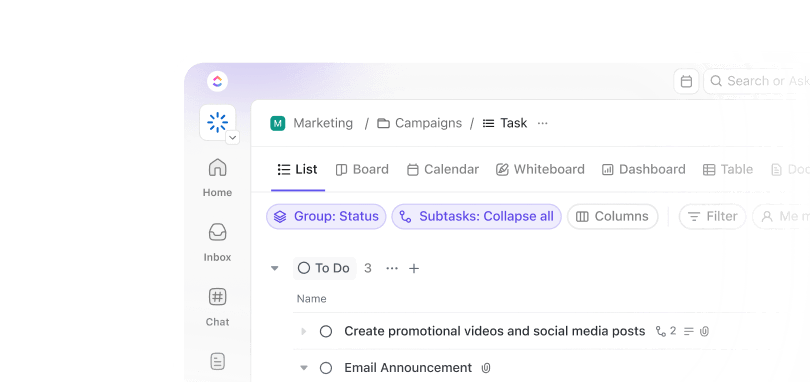Departmental boundaries and decentralized work can leave your team disjointed and in chaos. These challenges are even more evident within remote and hybrid teams, often to the point where it’s super obvious that the workplace lacks collaborative synergy.
Whether you’re grappling with conflicting priorities, communication hiccups, or resistance to change, this guide is for you. We’ll explore how cross-functional collaboration aims to break down these barriers and promote teamwork and communication among peers from different departments.
We’ll also explore some project management tools within , a top-rated collaboration and work management tool that can help multidisciplinary teams position themselves for future success. 🛸
What is Cross-Functional Collaboration, and Why Do Teams Need It?
Cross-functional collaboration serves as a powerful antidote to the pervasive “silo mentality” that tends to plague multi-department organizations.
In siloed teams, employees may refrain from sharing information with coworkers from another department, undermining efficiency and stifling innovation.
Cross-functional collaboration nurtures an environment that values knowledge sharing, motivating teams to work together to handle mutual objectives and challenges.
It’s like opening the doors that separate various departments, allowing skills and perspectives to converge, ultimately fostering innovation and enhancing the decision-making process.
Cross-functional collaboration promotes unity and transforms the workplace into a more engaging and fulfilling environment. The core idea is that the combined effort surpasses the sum of individual contributions!
11 Benefits of Implementing Cross-Functional Collaboration in Your Business
According to a survey by Deloitte, 83% of digitally advanced companies harness the power of cross-functional teams to stay “nimble” and “maintain a competitive edge.” While early-stage companies also value this type of collaboration, they’re often unable to tap into the right resources to make it happen.
Let’s dive into the eight most noteworthy benefits of cross-functional team collaboration below.
1. Enhanced innovation and creativity at work
Combining different expertise leads to unique ideas and breakthrough solutions. Employees challenge each other’s assumptions, fostering a culture of continuous improvement.
Example: A fashion brand’s marketing, product design, and sustainability teams collaborate to launch an eco-friendly clothing line, merging aesthetics with sustainability initiatives.
2. Better problem-solving and decision-making
When diverse skill sets come together, teams can tackle challenges more efficiently. Decisions are made with input from multiple perspectives, reducing blind spots.
Example: In a tech company, developers, designers, and customer support teams work together to quickly identify and fix user experience issues, preventing prolonged customer dissatisfaction.
3. Increased task efficiency
According to a Stanford University study, well-coordinated, collaborative teams are 50% more efficient at completing tasks than isolated workers.
Well, the best cross-functional teams don’t waste time duplicating efforts, as their workflows and responsibilities are clear. There’s also shared knowledge on standard operating procedures and the estimated time required for each task, all contributing to your team running like clockwork!
As a task management tool, helps you make any workspace more efficient, organized, and tailored to departmental needs.
4. Enhanced communication and employee engagement
When people from different departments team up, it’s like weaving a flag of togetherness. 🕊️
Team communication is the lifeblood of any cross-functional team, shaping its culture and propelling growth. The key to achieving this benefit often involves in-premise or online meetings and brainstorming sessions to discuss current or future work.
Most multidisciplinary teams rely on messaging and collaboration tools to facilitate a seamless flow of information among team members.
5. Alignment with company goals
It ensures that all departments are working toward common business objectives. This approach prevents misalignment in priorities by providing a holistic view of projects.
Example: A SaaS company launching a new feature ensures alignment between engineering (building the feature), marketing (positioning it effectively), and customer success (educating users on how to use it).
6. Better team-wide resource allocation
Cross-collaboration in action is all about resource optimization.
Building cross-functional teams avoids duplication of work by aligning efforts across departments. It optimizes talent allocation by leveraging each department’s strengths.
The beauty of effective resource allocation is that it’s not just about workload balance but the mental health and productivity throughout departments. It helps with meeting deadlines, reducing burnout, and improving job satisfaction, altogether creating a win-win situation for both the team and the organization. ✅
Example: A startup’s product team shares market research insights with marketing and sales, ensuring efforts are coordinated rather than each team conducting separate (and redundant) research.
7. Enhanced learning and development
Working in cross-functional teams strengthens leadership, communication, and problem-solving skills. Employees gain exposure to different areas of the business, increasing learning opportunities.
Example: A finance professional working on a cross-functional pricing strategy team gains insights into customer behavior from the sales and marketing teams, enhancing their business acumen.
8. Stronger accountability and trust
A broken team often plays the blame game when things go south, but healthy cross-functional teams are in a better position to establish accountability and learn collectively from failures.
Cross-functional collaboration fosters a sense of ownership, ensuring:
- Everyone feels responsible for a particular set of tasks
- Each member knows they’re a vital piece of the puzzle
- Conflicts between teams are resolved faster due to a shared sense of responsibility
Working together on cross-functional projects builds stronger relationships and trust among team members, fostering a positive and collaborative work culture.
Example: Instead of blaming another department for delays, a cross-functional project team works together to resolve bottlenecks and improve efficiency.
9. Enhanced customer experience
A cross-functional approach ensures that products and services are designed with the end user in mind. When multiple teams contribute insights, customer needs are addressed more effectively.
Example: A travel booking platform’s customer service, UX design, and engineering teams collaborate to improve website navigation, reducing customer complaints about a confusing interface.
10. Higher adaptability and resilience
Organizations can respond to market changes and disruptions faster when teams are already accustomed to working together across functions. This encourages a proactive, rather than reactive, approach to challenges.
Example: During a supply chain disruption, a retail company’s procurement, logistics, and sales teams work together to identify alternative suppliers and communicate delays transparently to customers.
11. Revenue and business growth
When departments collaborate effectively, businesses can optimize processes, reduce inefficiencies, and create more competitive products and services.
Example: A fintech company aligns its compliance, product, and marketing teams to quickly launch a new payment solution while ensuring regulatory approval and strong customer adoption.
How to Implement Cross-Functional Collaboration in the Workplace
Creating a cross-functional workplace requires strategic planning, clear communication, and the right tools. Here are key steps to successfully implement cross-functional collaboration:
1. Define clear goals and objectives
Ensure that every cross-functional initiative has a well-defined purpose aligned with the company’s broader objectives. Set measurable goals that all teams understand and work toward.
💡 Pro Tip: Set, share, and track measurable goals with Goals.
2. Establish leadership and accountability
Appoint a cross-functional leader or project owner responsible for overseeing collaboration efforts. Define clear roles and responsibilities to avoid confusion and ensure accountability.
💡 Pro Tip: Assign tasks and subtasks in Tasks to promote ownership.
3. Foster open communication and transparency
Use collaboration tools like , Microsoft Teams, etc., to keep communication open and organized. Encourage knowledge sharing through regular meetings, updates, and centralized documentation.
💡 Pro Tip: Chat is the ideal workplace communication tool. Chats link to tasks or docs mentioned, so you can see all of the conversations related to those assets, and all of the assets related to those conversations.
Use follow-ups to ensure that team members are responsible for follow-up actions, thereby reducing ambiguity and enhancing accountability. This makes sure nothing falls through the cracks.
4. Break down silos through cross-team interactions
Encourage employees to learn about other departments’ work through knowledge-sharing sessions or team rotations.
Create a culture where teams proactively seek input from other departments before making key decisions.
5. Implement standardized workflows and processes
Develop structured processes for cross-functional projects, such as decision-making frameworks or approval hierarchies.
Use project management methodologies like Agile or Scrum to keep teams aligned.
💡 Pro Tip: Create a repository of shared processes and documentation on Docs and enjoy faster deliveries, feedback loops, and updates. Plus, the power of Automation at your fingertips means you can bid farewell to repetitive tasks and instead focus on pushing common goals.
6. Leverage the right technology and tools
Integrate software that allows seamless collaboration between different teams. Ensure that data and insights are easily accessible across departments.
💡 Pro Tip: Leverage ’s 15+ views to provide teams with the required insights. For instance, the List view helps you sort and filter through huge data fields, while the Kanban Board and Calendar views are loved by agile project managers and team leaders who call the shots under tight deadlines.
7. Encourage a culture of trust and respect
Foster an environment where team members value each other’s expertise and feel comfortable sharing ideas. Address conflicts proactively and encourage constructive feedback.
Hold regular cross-functional brainstorming sessions where team members from different departments present challenges and collaborate on solutions.
8. Provide training and skill development
Offer workshops or training sessions on collaboration, communication, and project management. Encourage employees to develop cross-functional knowledge through mentorship or job shadowing.
9. Reward and recognize cross-functional success
Celebrate achievements that result from strong cross-functional teamwork. Offer incentives, such as performance bonuses or public recognition, to motivate employees to collaborate.
10. Continuously evaluate and improve collaboration efforts
Regularly assess the effectiveness of cross-functional initiatives through feedback and performance reviews. Adjust processes, tools, and structures as needed to optimize collaboration.
💡 Pro Tip: Collect feedback across the organization with customizable Forms.
Common Challenges Faced by Cross-functional Teams
Cross-functional collaboration brings together diverse expertise to achieve business goals, but it comes with its own set of challenges. Here are the main obstacles and ways to solve them:
Communication barriers
Effective communication is the backbone of successful cross-functional collaboration, but differences in terminology, work styles, and even geographical locations can create friction.
Different teams may use different jargon or communication channels, leading to misunderstandings. Remote or hybrid work can cause delays in responses and misalignment.
Similarly, some departments prefer formal communication, while others thrive in informal discussions.
Example: When developers mention “API endpoints” in a meeting, marketers may struggle to see how that impacts their campaign messaging.
Solution:
- Hold regular check-ins to clarify objectives, eliminate ambiguity, and foster open dialogue
- Establish a common language for collaboration. Create glossaries or conduct cross-team training to align terminologies (e.g., finance and marketing agreeing on what “ROI” means in different contexts)
- Use collaboration tools like to streamline discussions and maintain transparency
is your go-to for both sync and async communication. Use Comments within Docs for asynchronous feedback and discussions. You can even streamline workflow approvals with the Proofing feature, expediting the delivery process for documents, images, and videos.
Conflicting priorities
Different departments have their own goals, which can sometimes clash, making it difficult to move projects forward. Each team is driven by different KPIs, which may not always align with broader company objectives.
Example: A sales team wants a new feature released immediately to close deals, but the engineering team resists it because they need more time for testing. The conflict delays the launch and frustrates both teams.
Solution:
- Appoint a project owner who can balance different needs and negotiate trade-offs when conflicts arise
- Define shared KPIs that reflect both short-term and long-term business success, ensuring all teams work toward common goals
- Use frameworks like OKRs (Objectives and Key Results) to align priorities across departments and ensure that everyone understands how their work contributes to the bigger picture
Need help allocating resources? The Team view in provides a clear visual representation of who’s doing what and when, and with the ability to drag and drop tasks between different resources. Now, if you want to tweak your timeline or reorganize task dependencies within departments, the Gantt Chart view lets you do it with a few clicks.
Lack of clarity in roles and responsibilities
When multiple teams work together, overlapping responsibilities or unclear ownership can lead to duplicated efforts or, worse, neglected tasks.
Teams assume someone else is handling a task, leading to gaps in execution. Individuals hesitate to take ownership of cross-functional initiatives if responsibilities are unclear.
Example: A company launches a new software product, and both the marketing and product teams assume the other is responsible for customer onboarding materials. As a result, customers receive minimal guidance, leading to confusion and high churn rates.
Solution:
- Assign a project manager or cross-functional lead who ensures accountability and follows up on progress
- Use a RACI (Responsible, Accountable, Consulted, Informed) matrix to clarify roles, ensuring every aspect of the project is covered
- Clearly define ownership for key deliverables and communicate them across teams
Looking to establish transparent inter-departmental work processes? Take advantage of thorough task management within . Break large workflows into manageable tasks, create subtasks, and track progress, enabling quick issue detection and resolution.
If you notice any issues, customize problem-solving parameters with Custom Fields. For example, you can categorize and color-code priority levels, allowing you to focus on the most critical problems first. Plus, adding due dates and Reminders ensures timely issue resolutions across departments.
Resistance to change
Teams often resist new workflows, technologies, or collaboration methods, leading to inefficiencies and slow adoption of improvements.
Lack of involvement in decision-making can make employees feel that changes are imposed on them rather than benefiting them.
Example: A finance team has manually processed invoices for years, but the company implements an automated invoice approval system. The finance team resists the change, fearing job redundancy and unfamiliarity with the software.
Solution:
- Incentivize adoption through performance-based rewards or recognition programs
- Involve key stakeholders early in the decision-making process to get their buy-in and ensure they see the benefits of the change
- Provide comprehensive training and ongoing support to ease the transition
Technology and data silos
Siloed data and disconnected tools prevent teams from accessing the information they need, reducing efficiency and collaboration.
Often, different teams use separate tools that don’t integrate, making data-sharing difficult. This lack of visibility into cross-department data can lead to poor decision-making.
Example: A sales team uses CRM software to track customer interactions, while the customer support team uses a separate ticketing system. Without integration, sales reps lack visibility into past customer complaints, leading to poor customer experiences.
Solution:
- Encourage cross-functional data sharing through company-wide data access policies, ensuring teams have the right information at the right time
- Integrate systems using APIs or centralized platforms that connect different tools (e.g., linking the CRM with the customer support platform)
- Implement a shared dashboard that pulls data from multiple sources, providing a unified view for all teams
Dashboards boost decision-making practices within your team. Dashboards make team data and metrics visually accessible. With a wealth of reports and widgets, a team leader gains deeper insights into any project or productivity facet, making problem-solving and decision-making a breeze.
Decision-making bottlenecks
Slow decision-making can derail progress, especially when multiple approvals are required. Unclear authority can lead to back-and-forth discussions with no final decision, while multiple approval layers create unnecessary delays.
Example: A marketing team wants to launch a time-sensitive ad campaign but must wait for approvals from legal, finance, and compliance. The delays cause the campaign to miss its optimal launch window, leading to lower engagement.
Solution:
- Empower teams with decision-making autonomy within set guidelines to avoid unnecessary bottlenecks
- Establish clear decision-making protocols with predefined approval timelines and escalation paths
- Use a structured workflow for approvals (e.g., automated approval flows in project management software) to streamline processes
Best Practices for Effective Cross-Functional Collaboration
To leverage the full potential of cross-functional collaboration in your organization, adopt the following best practices:
- Clear team communication: Establish open and transparent communication channels to ensure that information flows freely between teams
- Shared objectives: Clearly define and communicate common goals to ensure that everyone is working towards the same outcome
- Roles and responsibilities: Outline the roles and responsibilities of each team member to avoid confusion and duplication of effort
- Regular meetings: Schedule regular cross-functional team meetings to discuss progress, address challenges, and share updates
- Respect for diverse perspectives: Embrace and value the diverse perspectives and expertise brought by each team, fostering a culture of respect and inclusion
- Collaborative tools: Implement collaborative tools and technology to facilitate information sharing and team management
- Feedback mechanism: Create a safe space for team members to share their ideas and concerns, ensuring continuous, bias-free improvement
- Conflict resolution: Develop a process for resolving conflicts or disagreements that may arise during inter-departmental collaboration
- Accountability: Establish a clear hierarchy within departments so that every member can be held accountable for their contributions and commitments to the collaborative effort
- Celebrate achievements: Recognize and celebrate milestones and organize team building activities to boost morale and motivation
Leadership Skills to Build Effective Cross-functional Teams
Building a successful cross-functional team requires strong leadership skills that foster collaboration, alignment, and efficiency. Here are key skills that leaders need to develop:
Communication skills
Leaders must clearly articulate goals, expectations, and updates across different teams. They should be able to translate technical or specialized information into a language that all team members can understand.
How to improve:
- Practice active listening to understand different perspectives
- Use simple and clear language to avoid misinterpretations
- Encourage open communication through regular check-ins and feedback sessions
Conflict resolution
Cross-functional teams often have competing priorities, and leaders need to mediate conflicts constructively. They must ensure that disagreements lead to better decision-making rather than delays or frustration.
How to improve:
- Develop negotiation skills to balance different viewpoints
- Stay neutral and focus on finding solutions rather than assigning blame
- Use frameworks like interest-based negotiation to resolve conflicts effectively
Emotional intelligence (EQ)
A high EQ helps leaders understand team dynamics, manage emotions, and create a positive work environment. It also enables them to recognize and address team members’ concerns before they become major issues.
How to improve:
- Practice empathy by putting yourself in others’ shoes
- Learn to recognize nonverbal cues that indicate frustration or disengagement
- Offer support and encouragement to create an inclusive team culture
Strategic thinking
Leaders must align cross-functional efforts with broader company objectives. They should anticipate potential roadblocks and plan accordingly.
How to improve:
- Develop a habit of looking at the big picture before making decisions
- Use data-driven insights to align teams with company goals
- Encourage proactive problem-solving instead of reactive fixes
Collaboration and team-building
Leaders must foster trust and teamwork between different functions. They should create a culture where team members feel valued and motivated to contribute.
How to improve:
- Encourage knowledge-sharing between teams to build mutual understanding
- Celebrate cross-functional successes to reinforce teamwork
- Set up mentorship or buddy systems to help teams work more cohesively
Adaptability
Leaders need to be flexible and open to change, as cross-functional projects often require adjustments along the way. They should be able to pivot strategies when needed without causing unnecessary disruptions.
How to improve:
- Stay updated on industry trends and best practices
- Develop a problem-solving mindset that embraces change as an opportunity
Influencing and stakeholder management
Leaders need to persuade different teams to align with a common vision, even when they don’t have direct authority over them. They must manage expectations and build relationships with key stakeholders.
How to improve:
- Use storytelling to make a compelling case for your ideas
- Understand each team’s priorities and frame your arguments in a way that resonates with them
By developing these skills, leaders can create highly effective teams that collaborate seamlessly, innovate efficiently, and drive business success.
4 Templates for Effective Cross-functional Collaboration
Here are four templates designed to streamline and enhance collaboration across diverse teams, ensuring your projects are a resounding success. 🥳
1. Cross-Functional Project Template
Need a shortcut for adapting cross-functional collaboration best practices? The Cross-Functional Project Template can be your team’s ally!
No more scattered documents or confusion—inside this folder template, you’ll find a dedicated space for every department involved in your project, like:
- Program Management Team
- Customer Services Team
- Sales Team
Each space has its own task list, making it easy for users to focus on departmental and overall responsibilities. But the real magic happens with the Gantt view. It provides a visual roadmap of your project’s timeline, helping you spot potential issues and bottlenecks.
Urgent Tasks act as your vigilant sentinel, guarding against task oversights, while Overview offers a panoramic view of your project’s landscape. With Progress Board, you can illustrate your project’s journey in the form of cards on a board.
In addition to the views, the template houses Project Docs, including a Program Charter to state objectives and define stakeholders and Meeting Minutes to capture meeting agendas and key takeaways.
2. Cross-Functional Project by Departments Template
Think of the Cross-Functional Project by Departments Template as your team’s personal assistant. It keeps everything organized and trackable by departments.
Every department you add gets a dedicated space for tasks. For instance, under the Marketing tab, you can add tasks related to advertising campaigns or social media strategies.
The beauty of this template is that it offers different views for each department. You can view tasks in a List format, see them laid out on a board, or check out what everyone’s working on with the Box view. 👀
The template is ideal for setting up task dependencies between departments, drastically reducing the time necessary to plan complex workflows. Use the Cross-Functional Gantt view to visualize these tasks on a timeline.
The default Custom Fields add more depth to your monitoring exercises, allowing you to rate performances, assign roles, track progress, and shuffle resources.
3. Cross-Functional Project Plan Template
The Cross-Functional Project Plan Template steps in as your guiding star, simplifying the planning and management of complex projects.
This template unfolds a seamless delivery structure right within , offering a range of features and views tailored for efficiency and organization. 🌟
You’ll find a well-structured List view that arranges Functional Deliverables, grouping activities by their respective team and status. Then, there’s the Progress Board view, a brilliant way to track activities through project stages. And, of course, the Gantt view unveils your project’s timeline, showing dependencies with crystal clarity. To add an extra layer of insight, the Product Timeline view reveals activity durations.
Effortlessly assign team members, involve stakeholders, designate project watchers, and set approvers for various workflow stages. This eliminates cross-team confusion and provides a personalized project overview for commencing and concluding each task.
4. Team Docs Template
The Team Docs Template is a fusion of Meeting Notes and a Team Wiki, creating a powerhouse of information at your fingertips. 👐
The Meeting Notes component is like a sharp blade, cutting through the chatter to capture the essence of your discussions. It neatly lists attendees, provides crucial links (like the meeting recording), pinpoints action items assigned to individuals, and lays out agenda items along with their corresponding notes.
This template also boasts a comprehensive Team Wiki, a central hub where you can easily access the names of your teammates and understand their roles within the group.
Together, this hybrid template is your ultimate tool for keeping your team informed, organized, and ready for action!
Embrace Cross-Functional Collaboration With
Cross-functional collaboration is one of those weapons that is widely available, but only a few teams can wield it skillfully. Many managers are still unsure how to enforce shared accountability—and even fear it!
Rome wasn’t built in a day, but with a dedicated approach to collaboration, you can start building your empire of innovation today by harnessing the power of . 🏰
Sign up for a free account and break free from the constraints of traditional siloed workflows!


Everything you need to stay organized and get work done.














